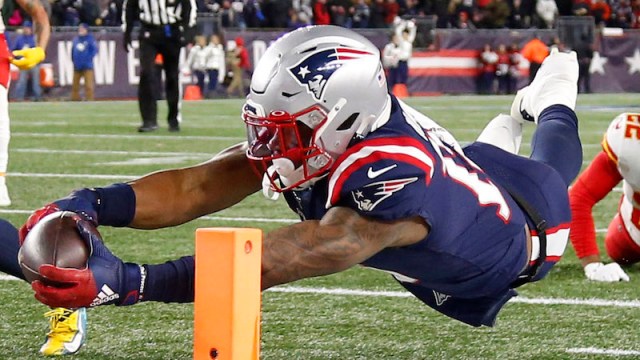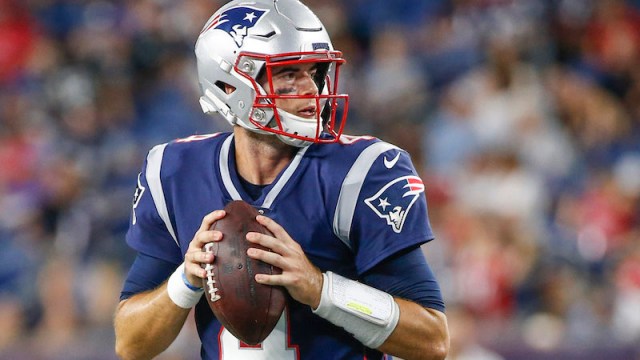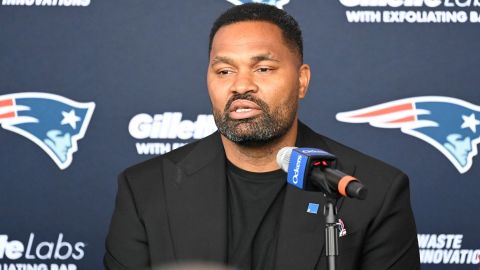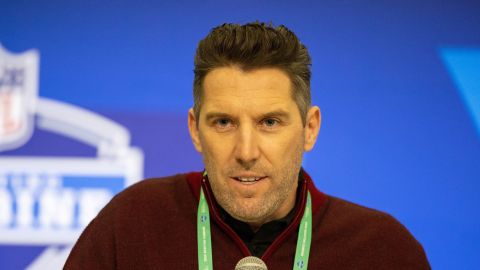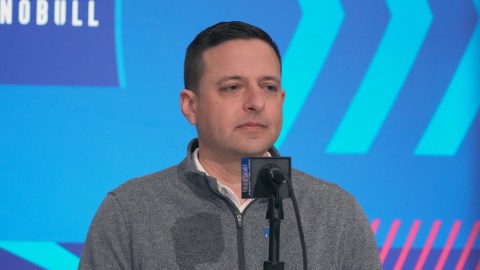J.J. Taylor is, in some ways, the prototypical undrafted free agent. The New England Patriots rookie running back is a player with upside and explosive traits but one seriously fatal flaw.
And for Taylor, that’s his diminutive stature. If Taylor wasn’t 5-foot-5, 185 pounds, he certainly would have been selected in the 2020 NFL Draft. And we understand that’s kind of like saying, “If Joe Burrow couldn’t throw a football, he wouldn’t have been drafted.”
Taylor’s lack of size is a big deal. He’s seemingly tied as the second-shortest player in NFL history. At the very least, he’s tied with former NFL wide receiver Trindon Holliday, both of whom measured in at 5-foot-5 and 1/4-inch, as the shortest players invited to the NFL Scouting Combine since 2000. Taylor is listed on the Patriots’ roster at 5-foot-6, 185 pounds, but that’s generous and incorrect. Taylor stands under 5-foot-5 and 1/2-inch, so he’s technically 5-foot-5.
The shortest player in NFL history, 5-foot-1 running back Jack Shapiro, played in just one or two games for the Staten Island Stapletons in 1929. So, Taylor is in rare company.
While Taylor is excessively short, it’s not as if players who stand under 5-foot-7 have never experienced NFL success. Tarik Cohen measured just 5-foot-6 and 3/8-inch, 179 pounds at his combine in 2017 and has accumulated over 4,100 all-purpose yards in three seasons.
Darren Sproles measured in at 5-foot-6 and 1/8-inch, 187 pounds at the combine in 2005 and picked up almost 20,000 all-purpose yards in his NFL career before earning All-Decade honors.
Patriots watchers know all about Dion Lewis, who measured in at 5-foot-6 and 5/8-inch, 193 pounds at the combine in 2011. He has nearly 5,000 career all-purpose yards and picked up 1,110 yards from scrimmage for the Patriots in 2017.
Even someone like Jacquizz Rodgers, who measured in at 5-foot-5 and 7/8-inch, 196 pounds at the combine in 2011, picked up over 5,100 all-purpose yards in eight NFL seasons.
So, Taylor isn’t doomed to fail despite his lack of height. His weight could be a bigger problem. But still, Sproles and Cohen have proven that short, light running backs can get the job done in certain situations, and he could bulk up his 185-pound frame.
At the same time, for every successful undersized back like Cohen, Sproles, Lewis, Rodgers or even Maurice Jones-Drew or Chris Thompson, there’s a Cory Ross, Robbie Rouse, Noel Devine, Garrett Wolfe, B.J. Catalon or Trey Williams who never produced to the same degree. Overall, running backs under 5-foot-8 who were invited to the NFL Scouting Combine between 2000 and 2017 produced a lower career approximate value than running backs who are 5-foot-8 to 6-foot-4. The sweet spot, oddly enough, was running backs who are 6-foot-1.
5-foot-7 and below: 10.3
5-foot-8: 10.5
5-foot-9: 11.5
5-foot-10: 12.4
5-foot-11: 12.1
6-feet: 11
6-foot-1: 23
6-foot-2: 11.5
6-foot-3 plus: 19
Similarly, running backs who weighed less than 190 pounds also had a lower career AV:
Less than 190 pounds: 7.4
190s: 9.8
200s: 10.8
210s: 14.5
220s: 13.3
230s: 12.3
240s: 23
250-plus: 22.2
Taylor’s closest athletic comp is Lewis. MockDraftable.com has them with an 82-percent similarity score. Taylor ran a 4.61-second 40-yard dash with a 7-second 3-cone drill, 4.15-second short shuttle, 34.5-inch vertical leap, 9-feet, 10-inch broad jump and 19 bench press reps of 225 pounds. Taylor was hand-timed with a 1.53-second 10-yard split, which is very fast. Taylor isn’t a phenomenal athlete, but his three-cone drill (60th percentile) and short shuttle (77th percentile) are both also above average.
More Patriots: Undrafted Receiver Offers Big-Play Ability
Taylor carried the ball 587 times for 3,263 yards with 18 touchdowns in four college seasons. He also caught 32 passes for 487 yards with two touchdowns and returned 41 kicks for 988 yards with a touchdown. His most productive season as a rusher came in 2018 when he carried the ball 255 times for 1,434 yards with six touchdowns. His best season as a pass-catcher came in 2019 when he caught 32 passes for 289 yards while carrying the ball 148 times for 721 yards with five scores.
Taylor dropped just two passes in 2019, per Pro Football Focus. He hauled in 63-of-80 targets in his college career for a 78.8-percent catch rate.
He averaged 3.3 yards after contact and .26 missed forced tackles per attempt during his final college season, per PFF.
Taylor didn’t fumble in 2019 and had just two fumbles in 2017. He did, however, fumble seven times in 2018.
Ultimately, he was a fun player to study. Despite his size, Taylor didn’t shy from contact. He could bounce off of would-be tacklers and keep moving. While he wasn’t as elusive as someone like Lewis, he did break some ankles in his college career. His ability to make something out of nothing was Lewis-esque, at times.
Taylor was effortless in using quick movements to find a lane or pick up extra yards, and that’s where his lack of size became an advantage. It also was impressive to see him accelerate from a stop.
He’ll likely be primarily used as a pass-catching back in the NFL. His pass protection could still use some work, but he was a willing blocker who flashed soft hands and good vision out of the backfield. Linebackers will be unable to handle his quickness. He also had some experience working out of the slot.
Taylor has an uphill battle to make the Patriots’ 53-man roster with five quality players ahead of him on the running back depth chart in Sony Michel, James White, Rex Burkhead, Brandon Bolden and Damien Harris.
If Taylor impresses and the Patriots are looking to trim some salary cap, they could elect to cut Burkhead or Bolden. It’s worth noting White is on the last year of his contract, so if the Patriots believe Taylor could be their future third-down back, they could look to stash him on the 53-man roster.
Taylor also offers special teams experience, averaging 24.1 yards per kick return. Bolden averaged just 22.4 yards per kick return in 2019 as the Patriots’ primary player in that role.
Based on his size and athleticism, it’s very easy to make the Lewis comparison with Taylor. It’s not entirely off base. Still, players like Cohen, Sproles, Lewis and Rodgers were drafted and Taylor was not for a reason. He’s small, lacks breakaway speed and lacked standout production in the Pac-12, especially in his final season at Arizona.
It will be fun to watch Taylor in training camp and preseason. He could wind up being the next running back to prove that size doesn’t necessarily matter at the position.

